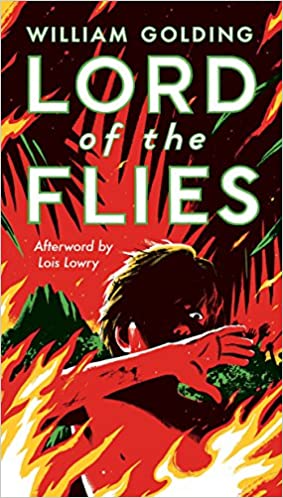
The story of Lord of the Flies, an allegorical novel by William Golding, takes place during a war on a deserted island, where a group of boys crashes. Outside of adult supervision, the boys have to find a way to survive and be rescued. Immediately, the setting reminds me of Robinson Crusoe, a survival-on-island fiction by Daniel Defoe. I easily expected a fun adventure of innocent boys just like the classic, but Golding had much more to offer. At first, the boys gathered under the leadership of Ralph, the protagonist of the story. However, the major conflict quickly plays out as Ralph, who wants the group to be organized and cooperate to get rescue, rivals with another boy named Jack, who only wants to hunt, with the group under his dictatorship. As the plot develops, the conflict only intensifies to become life or death.
The two boys represent different aspects of human nature. While Ralph represents law, order, and civilization, Jack represents savagery, chaos, and barbarism. With the story taking place in the backdrop of a war, and the book publishing not long after the Second World War, it is easy to infer Golding’s attempt to reflect on the question of “what is true human nature.” As the two sides of civilization and savagery clash, Golding offers a deep discussion of human nature and which side it leans towards, with the climax seemingly suggesting the latter. The book serves as a warning against “the darkness of man’s heart,” the inherent evil inside every person, even children, that human civilization is under the attack of. The name of the book, Lord of the Flies, is exactly that evil. It is not a visible, wicked Beelzebub that threatens to bring down human society, rather, it is inherent in all men as the violent instincts and savage impulses that constantly prompt us to destroy each other.
Spoiler alert: My favorite part of the book is a good example of human’s inherent savagery. When one of the boys, Simon, approaches a ritual-like feast created by the rest of the boys, his shadowy figure was mistaken for some kind of beast. The boys panicked and killed Simon. Ironically, even though the boys feared that a beast would hurt them, they were the ones to actually hurt one of their own, prompted by their violent, surviving impulse. The story of these children serves as an allegory for the adult world, where the exact same thing is happening, only on a scale of war.
One thing I find to be potentially inappropriate for the young readers is the book’s excessive use of violent and brutal language. However, older audiences may find the language as a powerful way to convey Golding’s message. The novel is not long and the story is compact, so I recommend this book to all older audiences, even to those who are not avid readers. Besides the thrilling plot, there is much that can be learned from this book. If you have never probed far into the question of human nature, this book will definitely give you something new.
Check out Lord of the Flies from the Newport Beach Public Library.